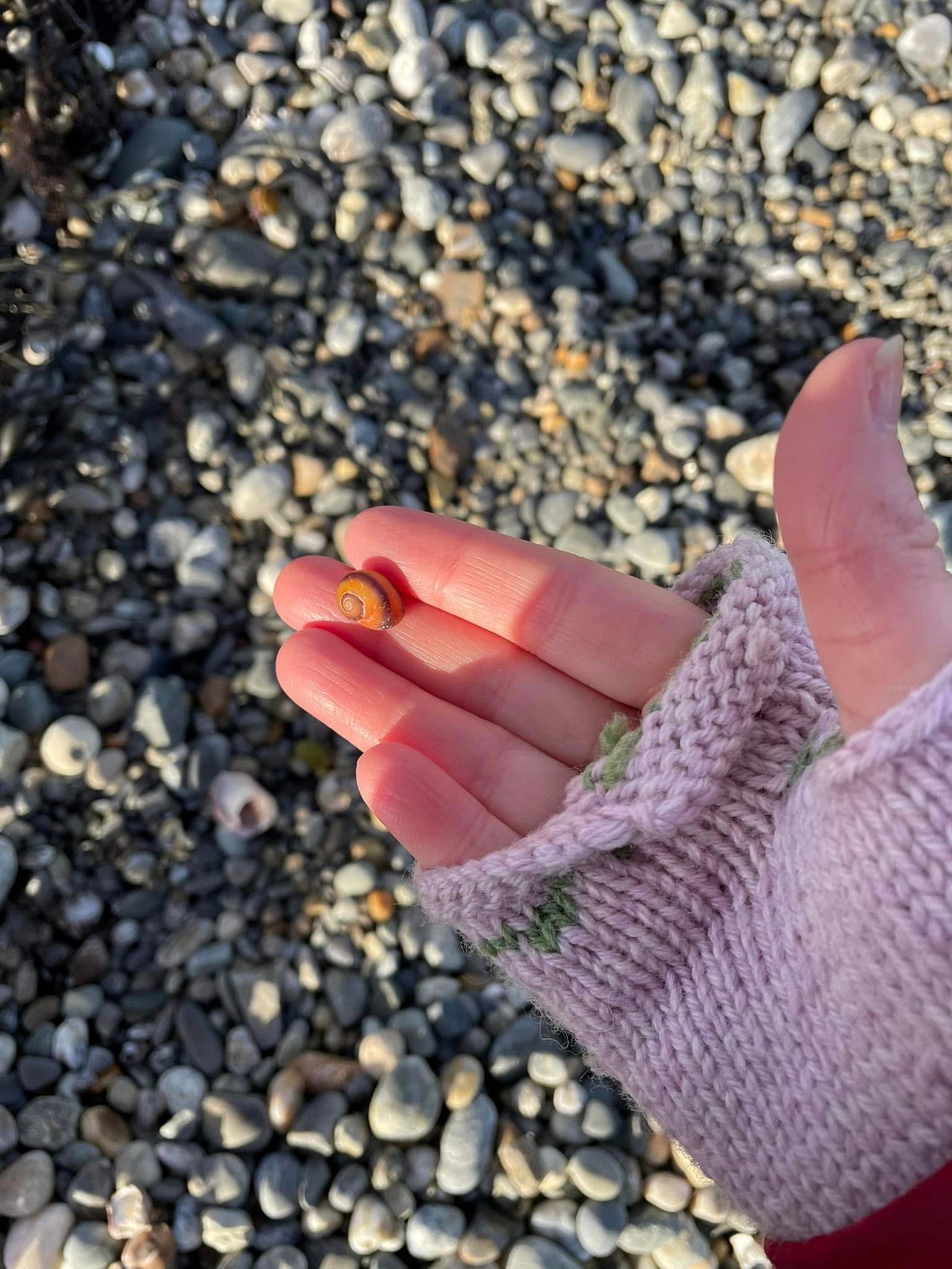A Handful of Periwinkles
Periwinkle ~ a sea snail belonging to the order Littorinidae, found worldwide.
Ah, periwinkles.
They are tiny, smooth, and round seashells that house a small sea snail. Often you can see them slowly moving around the shoreline and tidepools. They take their time, unhurried, and living to feed, mate and lay eggs. I have grown up seeing countless periwinkles on the beach. Because they are very common people overlook them and do not collect them when beachcombing. Yet I do. Why?
Periwinkles are found worldwide. Some of the best species are found in colder waters. These sea snails are hearty creatures, often preferring cold water for feeding and mating. They are one of the only shells you will find whole here along the natural rocky coastlines of New England. Most seashells here are often well beaten up due to the rough water and rocks. Yet some of the seashells are able to handle being tossed up onto rocks, and the periwinkle is one of them.
A seashell that I have come to love is small, rounded, smooth, and colorful. I only find it on naturally rocky shorelines of coves and pebble beaches. They do not grow very big, and are easy to fill your pockets with.
It is the Flat Northern Periwinkle ( Littorina obtusata ) that comes in several colors - reds, browns, oranges, yellows, bright green yellow, and even black. Sometimes they are banded. I have been lucky to find three of these banded varieties.
Now what makes them different colors or banded is beyond me. Several things factor: in the season, gender, age, water temp, supply of food, and what type of seaweed is around as periwinkles live most of their lives on these plants. While digging through a pebble and periwinkle pile, I come across many shades and sizes of this species as well as other periwinkles: the Rough Periwinkle ( Littorina saxatilis ) and the invasive non native Common Periwinkle ( Littorina littorea ) along with the variety of dogwhelks ( or winkles ) and the Waved Whelk ( Buccinum undatum ) which all handle the rough rocky coastlines with ease. These sea snails are tiny but important creatures for our ecosystems. They eat algae and sometimes forage for blue mussels or barnacle larvae. They keep the ocean free from becoming slimy from algae overgrowth. In other words, they are cleaners. I have come to respect these small creatures for their ability to do what us bigger and even so called humans cannot do: clean the oceans.
Seaweeds are where thousands can live for a long time. On each long leaf, they feed, rest, communicate with each other, mate, lay eggs, and eventually die. I am sure the seaweed benefits greatly from these sea snails, similar to how flowers benefit from the bees and butterflies. In many ways, the ocean world echoes the land.
It has been a joy to collect the Northern Flat Periwinkle in all its pretty hues and patterns. I’ve filled an entire bottle with some since they are such a common find here on the pebbled beaches. As I find them empty I wonder about each sea snail that at one time had been alive. What had killed it? Crabs are the main eaters, followed by shorebirds. Or seasonal changes, weather, and pollution. There is always a risk as is the way of life.
I am stunned by the many shapes, sizes, and colors of the three periwinkles found just in New England alone. As in the picture below, they blend in well with the beach debris and rocks. I cannot picture a rocky shoreline without them. Over the summer I have visited many different beaches on the New England coast and always manage to spot some. Some are empty, others alive and slowly roaming about. If I go over to the tidepools and move aside wet bunches of seaweed, I will find them sticking on the strands. I know I can find them firmly sticking to beach rocks next to limpets and barnacles, just waiting patiently for high tide to arrive so they are able to fully feed and mate. As a child, I would softly tap these shells and sometimes you would see them move a little as if you woke them up. I never tried to unstick them from the surface they were attached to, which could harm them. It is wise to let living sea animals of all kinds just be since each has a job to do, in one way or another.
One thing is for sure: despite moving slowly, these animals are very busy!
Each periwinkle female can lay thousands of eggs at a time - and this adds up as some sea snails can live up to 20 years. No one actually knows just how long these animals normally live, most books guess around 5 to 10 years, depending on the species.
This autumn I saw a periwinkle egg sac on the shoreline as the tide was going out. How it got there is unsure, since most egg sacs are carefully laid onto seaweed leaves round tidepools and shallow waters. Perhaps a strong wave tore the seaweed from its root and that is how the sac ended up along the small line of tiny seashells and wet sand. I was very excited to see it and thought it looked very interesting. I was reminded how delicate these sea snails’ lives are. They are often forgotten and much like barnacles, mussels, and surf clams, viewed as worthless. But they are survivors. Not only do they survive the rocky coastlines and cold water, but human activity has led many other sea creatures to endangered status.
Because of this, I have come to look at these creatures with admiration.
Next time you see a periwinkle, take a moment and give her a smile. You never know, she may smile back.
◌






